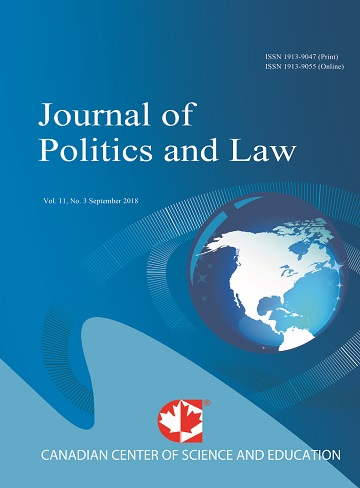An Application of the "Efficiency Gap" Measure to Redistricting in Oregon
- Priscilla L. Southwell
Abstract
This is a preliminary application of McGhee and Stephanopoulos’s efficiency gap measure to the state of Oregon for elections from 2012-2016. This is one of the measures currently being considered by the U.S. Supreme Court in the Gill v. Whitford gerrymandering case. Our results suggest that the current configuration of U.S, House districts minimizes the impact of a sizeable statewide Republican vote (@41-42%) that results in only 20% of the seats being given to this party. This disparity is less apparent in state senate and house seats, although the Democratic Party was at a distinct disadvantage in 2016 state senate elections. We also note the growing number of uncontested elections since this redistricting plan was first adopted in 2012.- Full Text:
 PDF
PDF
- DOI:10.5539/jpl.v10n5p152
Journal Metrics
h-index (2017): 14
i10-index (2017): 39
h5-index (2017): 9
h5-median (2017): 11
Index
- Academic Journals Database
- ACNP
- ANVUR (Italian National Agency for the Evaluation of Universities and Research Institutes)
- Berkeley Library
- CNKI Scholar
- COPAC
- CrossRef
- DTU Library
- EBSCOhost
- Elektronische Zeitschriftenbibliothek (EZB)
- EuroPub Database
- Excellence in Research for Australia (ERA)
- Genamics JournalSeek
- GETIT@YALE (Yale University Library)
- Ghent University Library
- Google Scholar
- Harvard Library
- HeinOnline
- INDEX ISLAMICUS
- Infotrieve
- Jisc Library Hub Discover
- JournalGuide
- JournalTOCs
- LOCKSS
- MIAR
- Mir@bel
- NewJour
- Norwegian Centre for Research Data (NSD)
- Open J-Gate
- PKP Open Archives Harvester
- Publons
- Pubmed journal list
- RePEc
- ROAD
- Scilit
- SHERPA/RoMEO
- Standard Periodical Directory
- Stanford Libraries
- UCR Library
- Ulrich's
- UniCat
- Universe Digital Library
- UoS Library
- WorldCat
- Zeitschriften Daten Bank (ZDB)
Contact
- William TaiEditorial Assistant
- jpl@ccsenet.org
